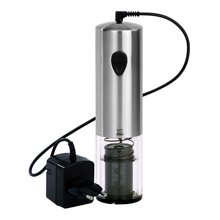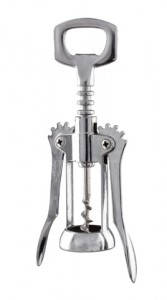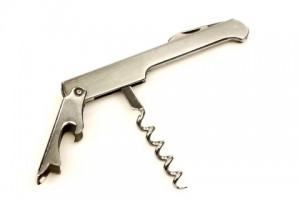 A few weeks ago we were having dinner with friends and again, a super-technical wine opening gizmo gave way to the cork. We stood around pondering the reason for the malfunction: batteries, user error or a defective cork.
A few weeks ago we were having dinner with friends and again, a super-technical wine opening gizmo gave way to the cork. We stood around pondering the reason for the malfunction: batteries, user error or a defective cork.
In the end we used a traditional waiter’s corkscrew to open the bottle. Just like an electric vs. hand-crank can opener, regardless of your preferred method, every household should have a standby wine opener.
There are several types of time-honored, low-tech corkscrews including the wing, waiter’s corkscrew and the twin-prong cork puller.
 The wing corkscrew (also called the butterfly) has two levers on each side of the worm. This opener makes it easy and almost effortless to pull the cork, even for the neophyte. The worm is inserted into the cork, the handles are pressed down and the cork slides out easily. They are inexpensive (on average less than $10) and come in a variety of styles.
The wing corkscrew (also called the butterfly) has two levers on each side of the worm. This opener makes it easy and almost effortless to pull the cork, even for the neophyte. The worm is inserted into the cork, the handles are pressed down and the cork slides out easily. They are inexpensive (on average less than $10) and come in a variety of styles.
 Most are familiar with the waiter’s corkscrew used in restaurants. It’s also known as a sommelier knife, waiter’s friend or wine key. The worm is manually screwed into the center of the cork, an arm extends to brace the opening of the bottle for leverage and with a single lever pull, the cork is lifted out. I have heard complaints of corks bending and breaking as they are being removed. This can occur if the cork is being pulled at an angle, causing the cork to break or tear.
Most are familiar with the waiter’s corkscrew used in restaurants. It’s also known as a sommelier knife, waiter’s friend or wine key. The worm is manually screwed into the center of the cork, an arm extends to brace the opening of the bottle for leverage and with a single lever pull, the cork is lifted out. I have heard complaints of corks bending and breaking as they are being removed. This can occur if the cork is being pulled at an angle, causing the cork to break or tear.
 The twin-prong cork puller is also known as the butler’s friend. Rather than using a screw mechanism, this corkscrew has two prongs that are wedged into either side of the bottle between the cork and the glass. With a quick twist the cork is out unscathed. I consider this corkscrew to be for the seasoned and experienced, simply because skill and care are necessary not to punch the cork back into the bottle.
The twin-prong cork puller is also known as the butler’s friend. Rather than using a screw mechanism, this corkscrew has two prongs that are wedged into either side of the bottle between the cork and the glass. With a quick twist the cork is out unscathed. I consider this corkscrew to be for the seasoned and experienced, simply because skill and care are necessary not to punch the cork back into the bottle.
After opening thousands of bottles of wine using openers from innovative to traditional, my dependable choice (as is the choice of most wine professionals) continues to be my waiter’s corkscrew.